
When it comes to discovering diabetes, it’s normal to have many questions. For example, what are the first signs of diabetes? Is there a difference between type 1 vs type 2 diabetes symptoms?
Recognizing diabetes signs and symptoms can lead to a quicker diagnosis and more choices in terms of treatment. Read on for tips on how to know if you have diabetes, including ways to identify early signs of diabetes.
What Is Diabetes?
Diabetes is a chronic condition that affects the body’s ability to make and use insulin properly. In the case of both type 1 and type 2 diabetes, cells in the pancreas fail to respond to insulin correctly. Since insulin works to transport blood sugar into the body’s cells, diabetes can cause a dangerous rise in blood sugar in the bloodstream.
Ultimately, diabetes complicates the way your body makes and uses energy. Having levels of blood sugar that are too high for too long can cause damage to the body’s cells and tissues. Early diabetes diagnosis is key to managing risks.
Diabetes Risk Factors
Many people are unaware that they are at risk for developing diabetes. This is especially true for the risk of developing type 2 diabetes since lifestyle factors play a significant role.
Risk factors for type 2 diabetes include:
• Excess body fat (especially abdominal)
• Family history of diabetes
• High blood pressure or high cholesterol
• History of gestational diabetes
• Impaired glucose metabolism
• Older age (being older than 45 years)
• Overweight or obese BMI
• Lack of physical activity
Left untreated, diabetes can become a risk factor for other diseases or conditions. For example, having diabetes increases the risk of experiencing the following:
• Heart attack
• Kidney disease
• Nerve damage
• Stroke
• Vision loss
Diabetes Signs and Symptoms
Searching for symptoms of diabetes? Here are seven signs to be on the lookout for.
1. Prediabetes
As the name indicates, prediabetes is a condition that increases the risk of developing type 2 diabetes. If you’re getting regular blood work done to watch for diabetes, your doctor may have already alerted you to this condition. However, not everyone is diagnosed with prediabetes before being diagnosed with type 2 diabetes.
Prediabetes is considered a “transition step” to type 2 diabetes and is often called ‘impaired glucose tolerance.’ A diagnosis of prediabetes indicates that blood sugar is higher than normal, but not quite high enough to qualify as a diabetes diagnosis. Additionally, prediabetes indicates an increasing level of insulin resistance, meaning the body is becoming less sensitive to insulin.
In other words, prediabetes is an important warning sign and can empower you to make meaningful lifestyle changes. For example, altering your diet and increasing physical activity can help you return to a normal blood glucose range.
2. Changes In Mood or Energy Levels
Shifts in blood sugar levels can have a big effect on mood. Feeling unusually irritable, tired, or weak can be a subtle signal that your body is having trouble balancing blood sugar.
A number of other diabetes symptoms can complicate your ability to obtain a good night’s sleep, furthering your fatigue. For example, frequent urination may disrupt sleep.
This type of fatigue is more than merely “feeling tired”—it’s extreme fatigue interrupts daily function and can severely impact your quality of life. Learning to monitor blood sugar can help you better manage your energy levels.
3. Unexplained Weight Loss
While being overweight or obese is a risk factor for type 2 diabetes, losing weight without trying can also be concerning and may indicate the onset of type 1 diabetes. When the body isn’t using sugar effectively for energy, it can begin to rely on burning fat stores. Ultimately, this can cause unintended weight loss.
4. Blurred Vision
One side effect of diabetes is worsening vision. Vision changes may indicate damage to the tiny blood vessels of the eyes, which can occur when high blood sugar levels cause a buildup of plaque or pressure.
In the short term, rising blood sugar levels may cause blurry vision for several days or weeks. This kind of blurry vision is usually temporary, and may be corrected with medication or when blood glucose levels return to normal
Long-term, elevated blood sugar can cause swelling of eye tissues. Sometimes, the eye tissues will try to adapt by growing new, but weaker, blood vessels. If rising blood sugar and blood vessel problems aren’t addressed, diabetes can lead to more serious eye disease issues, including:
• Blindness
• Cataracts
• Diabetic retinopathy
• Diabetic macular edema
• Glaucoma
5. Numbness
Just as elevated blood pressure can damage the tiny blood vessels of the eyes, it can also damage other small blood vessels. These vessels, called capillaries, feed the nerves. When these blood vessels are blocked or pressure builds up, nerve damage and poor circulation can naturally occur.
Starting with the toes or fingers, a feeling of tingling may begin and gradually stretch to other parts of the body. While this type of neuropathy may seem harmless initially, it can lead to something more serious.
For example, males may experience erectile dysfunction. Both men and women may have problems related to digestion, such as:
• Constipation
• Diarrhea
• Nausea
• Vomiting
Numbness is an important symptom and should not be ignored. Sometimes, it feels like a burning pain or a loss of sensation. Left untreated, neuropathy can lead to foot damage (even amputation in serious cases).
6. Increased Thirst & Urination
An unusual level of thirst is one of the hallmark signs of diabetes. Another common symptom of diabetes is an increased frequency of urination, or taking more trips to the bathroom, particularly at night.
During diabetes, blood sugar builds up in the blood and causes the kidneys—which filter fluids—to work overtime. The kidneys cannot absorb the extra glucose in the blood, and as a result, glucose exits the body through the urine, dragging fluid-like water along with it.
Ultimately, this can cause an intense thirst, and even lead to dehydration. Unfortunately, drinking more water won’t solve the problem, since it will likely cause you to urinate even more.
7. More Infections & Slow Healing Time
People with diabetes tend to have weaker immune systems when compared to healthy individuals. This means having prediabetes or diabetes may make you more prone to frequent infections or illness.
In particular, people with diabetes can have an increased susceptibility to yeast infections or urinary tract infections (UTIs). When blood sugar lingers in the bloodstream, the kidneys can have difficulty filtering properly. As a result, more sugar ends up in the urine, creating the perfect environment for bad bacteria to feed.
Another signal that something might be wrong is developing sores that do not heal. Skin or mouth sores may develop, along with any of the following problems:
• Bacterial or fungal infections
• Red, swollen, or tender gums
• Skin problems
Type 1 vs Type 2 Diabetes Symptoms
While some symptoms of type 1 and type 2 diabetes overlap, there are some key ways in which the two main types of diabetes differ.
People with type 1 diabetes are usually diagnosed as young children or teens, although diagnosis can occur at any age. Type 1 diabetes is considered an organ-specific autoimmune disease since the body has an immune response against the cells in the pancreas that produce insulin. It’s often been called the “genetic” type of diabetes, since the risk of a child being diagnosed with diabetes increases if one or both parents has type 1 diabetes.
A major hallmark of type 1 diabetes is that the onset is sudden, usually happening over a period of weeks. Modifying diet and lifestyle cannot prevent type 1 diabetes but may be a crucial part of the treatment plan. Type 1 diabetes is much less common than type 2, with only 0.55% of U.S. adults reporting being diagnosed with type 1 diabetes.
Type 2 diabetes, on the other hand, affects nearly 8.6% of the U.S. population (about 21 million adults). Unlike type 1 diabetes, it usually develops gradually over several years, and most individuals with type 2 diabetes are characterized as overweight or obese according to body mass index (BMI).
While some people may be genetically more prone to type 2 diabetes than others, lifestyle factors like diet and exercise can play a major role in reducing your risk of developing this type of diabetes.
What To Do If You Think You Have Diabetes
The sooner diabetes is diagnosed, the sooner you can pursue treatment. If you think you may have diabetes, you can ask your doctor to conduct the following:
• Fasting Plasma Glucose Test: Indicates the amount of glucose (sugar) in the blood after 8-12 hours of fasting.
• Oral Glucose Tolerance Test (OGTT): Indicates how the body uses glucose over time. After an overnight fast, a blood sample is taken. Then, the patient drinks a high-glucose beverage and another blood sample is taken (usually every hour for three hours following ingestion of the beverage).
• A1C Test: Indicates average blood glucose range within the past 2-3 months. It can be used to identify prediabetes or diabetes and measures the amount of sugar that “sticks” to red blood cells in the body.
Having any of the above-listed symptoms is reason enough to see a doctor. Many treatment options, such as insulin pumps, are available and may help you achieve a better quality of life. If left untreated or if symptoms go unnoticed, diabetes can lead to life-threatening situations like diabetic ketoacidosis.
In Summary on Diabetes Symptoms
Listening to your body and learning about common symptoms can help you catch diabetes more quickly. Identifying prediabetes can help you tackle concerns early on, and can motivate you to stay within a healthy blood sugar range. Although the onset of type 1 and type 2 diabetes differs, many of the symptoms are the same and can alert you before problems progress.
References:
American Diabetes Association. Diabetes Symptoms. Diabetes.org. Accessed April 2023.
American Diabetes Association. Learn the Genetics of Diabetes. Diabetes.org. Accessed April 2023.
American Diabetes Association. Understanding Diabetes. Diabetes.org. Accessed April 2023.
Centers for Disease Control and Prevention. Diabetic Ketoacidosis. Cdc.gov. Published December 2022.
Centers of Disease Control and Prevention. Prevalence of Diagnosed Diabetes in Adults by Diabetes Type — United States, 2016. Weekly. 2018;67(12):359-361.
Cleveland Clinic. Is Diabetes Sneaking up on You? 6 Early Signs. Health.clevelandclinic.org. Published March 2022.
Ellis E. Understanding Diabetes. Eatright.org. Published November 2021.
Ellis E. What Is Prediabetes? Eatright.org. Published November 2021.
Kawasaki E. Type 1 Diabetes and Autoimmunity. Clin Pediatr Endocrinol. 2014;23(4):99-105.
Mayo Clinic. Diabetes. Mayoclinic.org. Published January 2023.
Mayo Clinic. Diabetes symptoms: When diabetes symptoms are a concern. Mayoclinic.org. Published June 2021.
Mohammed L, Jha G, Malasevskaia, Goud HK, Hassan A. The Interplay Between Sugar and Yeast Infections: Do Diabetics Have a Greater Predisposition to Develop Oral and Vulvovaginal Candidiasis? Cureus. 2021;13(2):e13407.
National Institute of Diabetes and Digestive and Kidney Diseases. Diabetic Eye Disease. Niddk.nih.gov. Published May 2017.
National Institute of Diabetes and Digestive and Kidney Diseases. Symptoms & Causes of Diabetes. Niddk.nih.gov. Published December 2016.






